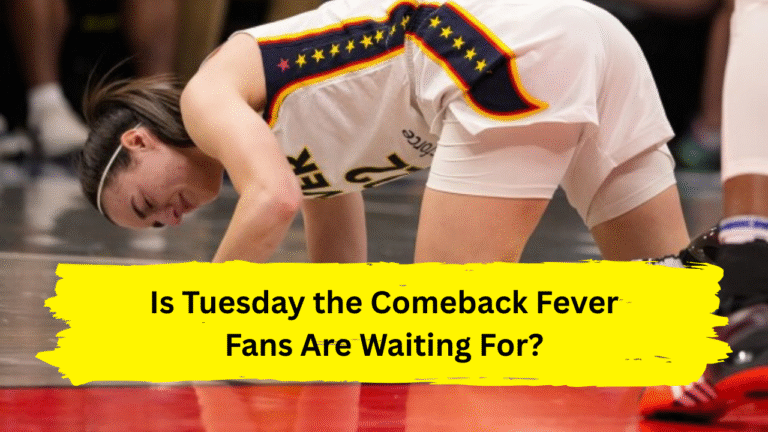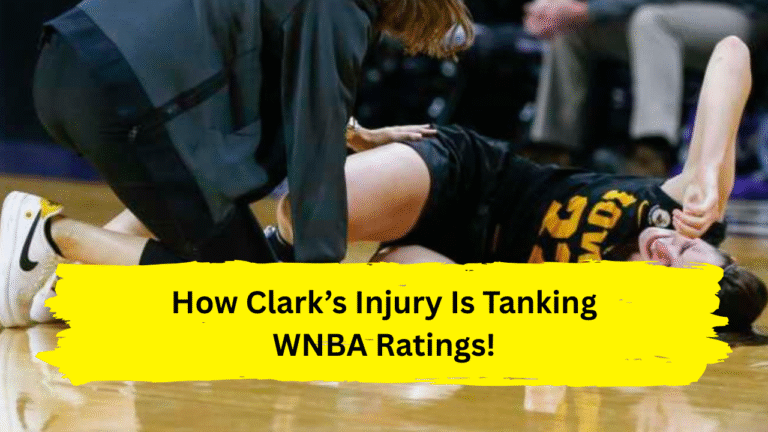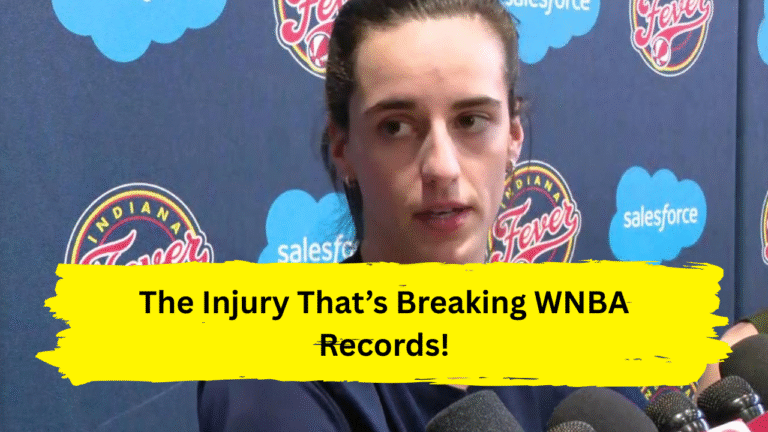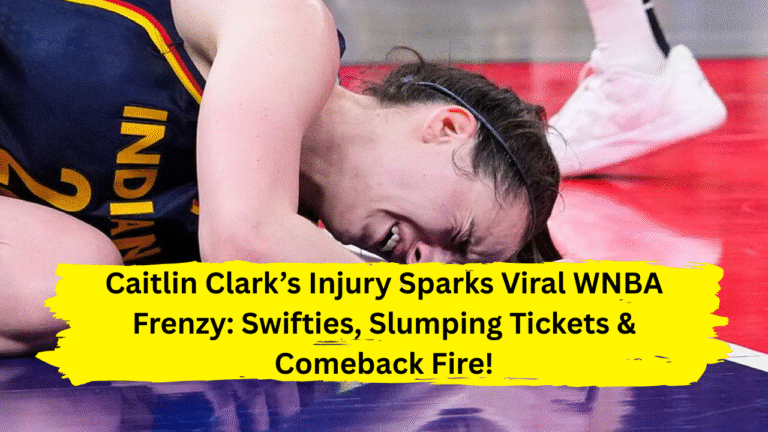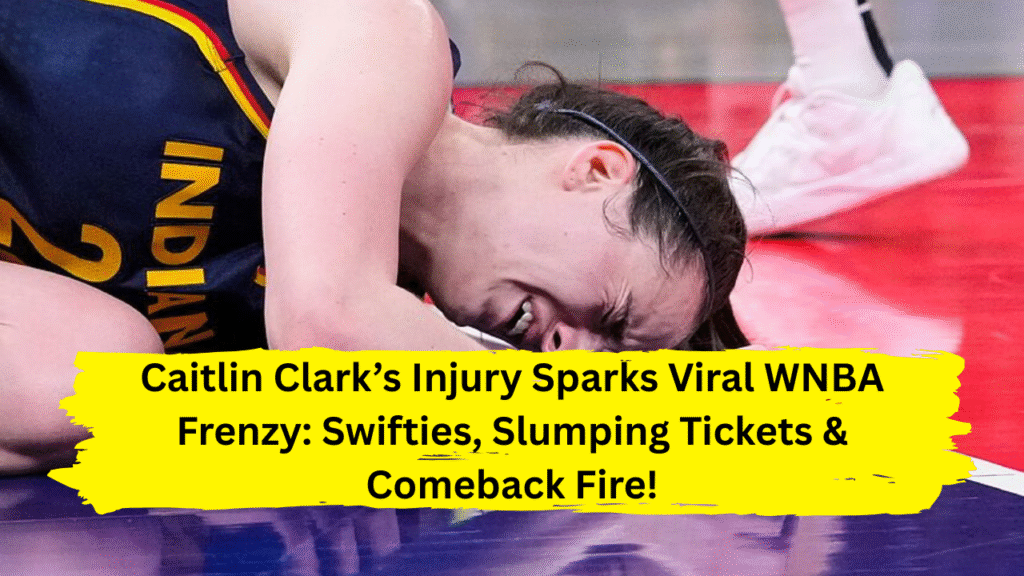
Caitlin Clark’s quad injury sidelined the WNBA superstar, sparking viral fan frenzy over her Taylor Swift merch, crashing ticket prices, and igniting comeback fever. Discover how one athlete’s absence reveals her seismic cultural impact beyond the court. Dive into the drama now!
The roar of 17,608 fans – the largest crowd in Atlanta Dream history – still echoed in the air. Caitlin Clark had just sliced through the defense, executing a behind-the-back move so slick it froze Grammy-winning rapper Lecrae mid-reaction, his jaw-dropping disbelief captured and shared across a million screens . Yet, just days later, an unsettling silence fell. Not the quiet of an empty gym, but the palpable hush of an entire league holding its breath. On May 24th, 2025, during a nail-biting 90-88 loss to the New York Liberty, Clark grabbed her left leg. The diagnosis? A left quadriceps strain, sidelining the Indiana Fever phenom for at least two weeks . What followed wasn’t just sports news; it was a cultural tremor. A simple black t-shirt featuring Taylor Swift’s face, worn by Clark as she boarded a team flight, exploded online, “reppin’ T-Swift baby!” becoming a defiant anthem for fans facing her absence . Overnight, ticket prices for the Fever’s marquee rematch against Angel Reese and the Chicago Sky plummeted 71%, from $86 to a mere $25, laying bare the “Clark Effect” in startling, economic terms . This is the story of how one player’s injury transcended the sidelines, exposing the fierce adoration, fragile economics, and viral power swirling around Caitlin Clark in her monumental second year.
The Sting of the Sideline: Clark’s Injury Blow and the Swiftie Salute
The 2025 season dawned with Caitlin Clark operating at a peak only hinted at during her Rookie of the Year campaign. She stormed out of the gates with a statement triple-double: 20 points, 10 rebounds, and 10 assists against rival Angel Reese and the Chicago Sky . “We are so back… YEAR 2❤️🔥,” she declared on Instagram during Media Day, a post that sent her 3.1 million followers into a frenzy, foreshadowing the amplified spotlight of her sophomore surge . Her averages – 19 points, 9.3 assists, and 6 rebounds – weren’t just numbers; they were proof of her evolution, the result of an offseason dedicated to building strength and refining her generational talent .
Then came the gut punch. Driving hard against New York, familiar fire in her eyes, Clark felt the pull in her left quad. The immediate diagnosis – a strain requiring at least two weeks of recovery – was a blow to the Fever’s early momentum and the league’s soaring attendance figures . Coach Stephanie White preached caution, emphasizing the “long-game approach” to protect their franchise cornerstone, acknowledging the delicate balance between fan desire and player health: “Obviously, everyone wants to watch her play… But for me, it’s maintaining perspective… making sure we address this in a way that doesn’t affect [the] long term” .
True to her resilient nature, Clark was spotted casually working on jumpers and layups just days later, teammate Damaris Dantas playfully urging restraint . But it was a seemingly off-court moment that truly defined this phase of her absence. Stepping towards the team plane, Clark radiated a different kind of confidence. She wore simple black track pants, white sneakers, and a bold, black Taylor Swift Eras Tour t-shirt – “the best shirt in the world!” as she later grinned . The Fever’s Instagram post (“Caitlin Clark reppin Taylor Swift”) ignited the internet. Fans flooded social media, views soared past 630,000, and Clark’s cheeky caption – “Duh” – perfectly encapsulated the unapologetic fandom shared by millions . This wasn’t just merch; it was a symbol of normalcy, a shared pop-culture language, and a reminder of the bond between two superstars who’d cheered together in a Chiefs suite – “very normal people,” as Clark once described them, living distinctly abnormal lives . Speculation ran wild: would Swift return the favor and rock Fever colors courtside? The viral frenzy over a t-shirt underscored a truth: everything Clark touches, even while injured, turns to cultural gold.
The Economic Earthquake: Ticket Crashes and Plastic Tributes
Caitlin Clark’s impact on the WNBA is often measured in highlight reels and social media metrics, but her injury delivered a stark, quantifiable lesson in her economic power. The announcement of her absence sent immediate shockwaves through the secondary ticket market. Nowhere was this more dramatic than for the highly anticipated June 7th rematch against Angel Reese and the Chicago Sky. Originally scheduled for the 10,000-seat Wintrust Arena, demand fueled by the Clark-Reese rivalry had already forced a venue upgrade to the 21,000-seat United Center . Yet, within 48 hours of the injury news, the bottom fell out. Get-in prices collapsed, plunging a staggering 71% from $86 to just $25 . Analytics from platforms like TickPick and SeatGeek confirmed the trend, with average prices across the board dropping roughly 42% from $137 to $80 . Front Office Sports starkly reported the “Clark Effect” in reverse: her absence wasn’t just a lineup change; it was a market correction.
This tangible financial impact highlighted a harsh reality the league is navigating: while overall interest is undeniably up, a significant portion of the WNBA’s recent surge in ticket sales and visibility rides on the drawing power of a few transcendent stars, with Clark leading the charge. It underscored how crucial her presence is to converting casual interest into committed ticket purchases, especially for marquee matchups.
Yet, even from the sidelines, Clark’s commercial dominance found new avenues for expression. Just days before her injury, Funko sent the collectibles world into a frenzy by announcing the first-ever WNBA Pop! figures, with Clark headlining the lineup alongside A’ja Wilson, Angel Reese, and Breanna Stewart . Fan reaction was instantaneous and overwhelming. “You better make a million of the Caitlin Clark ones because those are going to sell quickly,” demanded one fan online. Others declared, “I don’t give af if that shipping fee costs more than my tuition fee, I GOTTA HAVE THE CAITLIN CLARK FUNKO,” and “Another thing Caitlin Clark will dominate. Definitely will be getting my #FunkoPop” . This explosion of excitement for a plastic figurine, announced coincidentally near her injury, served as a potent symbol. It reaffirmed her status as a must-have icon, a player whose cultural cachet translates into tangible demand, ensuring her presence – even in vinyl form – would still dominate shelves and fan collections while she heals. The message was clear: whether on court or off, Caitlin Clark moves markets, both real and collectible.
Beyond the Hype: Vulnerability, Community, and the Comeback Forge
The whirlwind of viral merch moments and ticket price plunges painted a picture of Clark’s celebrity. Yet, her injury also revealed a different, more grounded facet of her burgeoning stardom: vulnerability and genuine connection. The sight of the seemingly unstoppable force sidelined resonated. It humanized the athlete whose superhuman passes and logo threes often defy belief. Fans weren’t just missing the highlights; they were expressing genuine concern for Caitlin, the person who embodied their hopes for the Fever and the league’s soaring trajectory. This vulnerability, however, was met not with retreat, but with Clark’s characteristic resilience and outward focus.
Her response mirrored the support she’d famously received. When news broke of USC superstar JuJu Watkins’ devastating torn ACL during the NCAA tournament, Clark was quick to offer public solace. “Sending all my thoughts and prayers to JuJu. Kid will come back stronger than ever,” Clark posted on X, adding a red heart . This gesture placed her alongside legends like Lisa Leslie and peers like Angel Reese (who posted “Prayers for Juju!”) in a chorus of support for the injured freshman . It was a poignant moment, one superstar sidelined in the WNBA reaching out to another facing a far longer rehab road in college, highlighting the supportive network woven through women’s basketball.
This sense of community, amplified during her own setback, extends beyond individual gestures. Clark’s mere presence, even limited, at practice – grinning while lightly shooting, defying the urge to fully push – became a symbol of hope for Fever fans . It whispered the promise of a return. Her engagement online, from the Swift post to likely seeing the tidal wave of Funko excitement, kept her connected to the fanbase riding the emotional rollercoaster with her. While Coach White and the medical team enforced necessary caution (“Sometimes great players don’t tell you when they’re hurting” ), Clark’s demeanor signaled a competitor already mentally mapping her path back. This period of forced absence, punctuated by viral flashes and quiet support for others, wasn’t just about recovery; it was a forging fire for the next chapter of Year 2. The vulnerability shown made her relatable; the resilience simmering beneath the surface made her return inevitable.
The Clark Catalyst: How One Injury Revealed a Cultural Phenomenon
Caitlin Clark’s quad strain was a medical footnote. Its reverberations, however, were seismic, laying bare the multifaceted phenomenon she has become. Her brief step away from the hardwood wasn’t merely an absence in the Fever’s rotation; it was a lightning rod for cultural conversations far beyond sports. The overnight tanking of ticket prices for the Fever-Sky showdown wasn’t just a market fluctuation; it was a stark, quantitative measure of the “Clark Effect” – her unparalleled power to drive eyeballs, fill arenas, and generate revenue . This economic tremor proved that the WNBA’s soaring popularity, while built on incredible talent league-wide, currently enjoys a significant accelerant in Clark’s drawing power. Teams weren’t just moving games to bigger arenas for Clark; the expectation of her presence fundamentally altered the financial landscape of individual games.
Simultaneously, the explosive reaction to a simple Taylor Swift t-shirt transcended typical athlete fan behavior . It became a shared cultural moment, uniting Swifties and sports fans in a viral celebration of fandom and female iconography. This effortless ignition of online frenzy underscores Clark’s unique position: she’s not just a basketball player; she’s a full-fledged pop culture entity. Like Swift, she commands attention, moves merchandise, and aggregates massive social media engagement simply by being herself . The parallels are undeniable – the arena-filling demand, the coveted endorsements (Nike, Gatorade, State Farm), the ability to make headlines with a single post or outfit. Clark’s injury, ironically, amplified this aspect of her stardom. The Funko Pop! announcement frenzy, coinciding with her sidelining, further cemented her status as a must-own icon, a player whose likeness holds value even when she’s not draining threes .
Perhaps most tellingly, the injury revealed the depth of emotional investment fans have in Clark’s journey. The concern wasn’t just fantasy stats or wins; it was personal. People connected with the vulnerability of the seemingly invincible star being momentarily grounded. Her quiet support for JuJu Watkins resonated because it reflected empathy born from her own experience . Even her defiantly casual jumpers during practice became symbols of an indomitable spirit fans felt invested in . Lecrae’s viral disbelief days before her injury captured the awe she inspires ; the reaction to her injury captured the affection.
The buzz of anticipation is already building again. The two-week timeline nears its end. While the Fever navigate games relying on Aliyah Boston’s paint presence and Kelsey Mitchell’s backcourt leadership, the question on everyone’s lips isn’t just when Caitlin Clark will return, but how she will return . Will the brief respite refuel her trademark fire? Will the leg, meticulously cared for by the Fever’s staff, allow her to explode back onto the court with the same game-breaking force? One thing is certain: her comeback game won’t just be a sports event. It will be a cultural moment. Tickets, recently languishing, will soar once more. Social media will ignite. Every crossover, every no-look pass, every deep three will be dissected with glee. The vinyl Caitlin Clark Funkos will fly off shelves as tangible totems of her resumed reign .
Caitlin Clark’s injury was an unwelcome pause. Yet, in true Clark fashion, she managed to write a compelling, unexpected chapter from the sidelines. It was a chapter that proved her influence is measured in more than points and assists – it’s measured in viral t-shirts, crashing ticket algorithms, collective groans at her absence, and the unwavering belief that she’ll return, “reppin’ T-Swift” and ready to once again leave defenders, and rapper Lecrae, frozen in awe . The Fever’s playoff push awaits. The WNBA’s spotlight intensifies. The sideline interlude is almost over. Caitlin Clark’s Year 2 saga, fueled by injury, viral frenzy, and undeniable talent, is poised for its most electrifying act yet. Get ready. The show is about to start. Again.
Also Read: Latest Trending News

